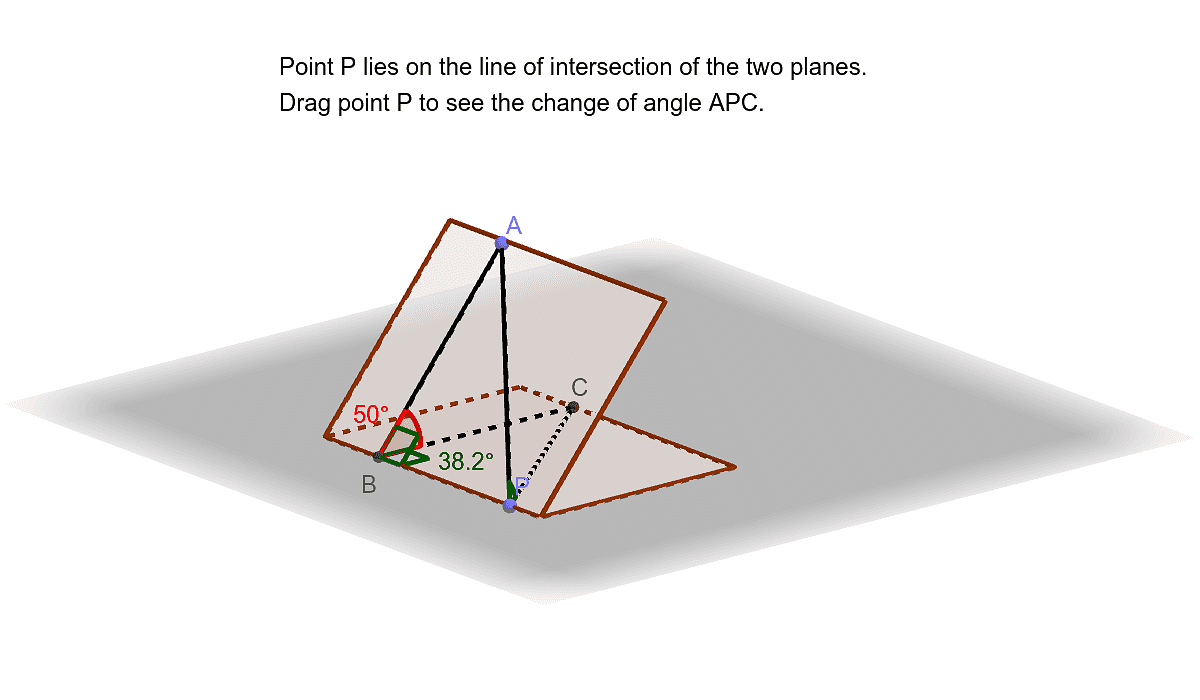
Content Strategy Manager
Angles between two planes refer to the acute angle which is decided on by the standard vectors of the planes. Two planes are said to be perpendicular if their standard vectors are rectangular. This particular portion tells us what plane is and what is the angle between the two planes, it also shows us how to calculate the angle between the two planes in a Cartesian plane.
| Table of Content |
Keyterms: Angles, Planes, acute angle, rectangular, vectors, Cartesian plane, flat surface
Read More: Symmetric Matrix
Definition of Plane
[Click Here for Sample Questions]
A plane is defined as two dimensional in nature and a flat surface that prolongs infinitely far in two dimensions. It is formed by some stack of lines that are kept side to side to each other.
Read More:
| Chapter Related Articles | ||
|---|---|---|
| Three - dimensional Geometry Introduction | Triangle law of vector addition | Angle between a Line and a Plane |
| Equation Line | Angle Between Two Vectors | Angle between two lines |
Angle Between Two Planes
[Click Here for Sample Questions]
The angle that is between the normal to the two planes is known as the angle between the planes.

Let us assume that vectors n1 and n2 are the two respective normals to two plane surfaces that are aligned to each other at angle. We can hence determine the equations of the two planes as-

As we know, the cosine angle between two planes can be calculated by calculating the angle between their normal.
Therefore,

Calculation of The Angle Between Two planes in the Cartesian Plane
[Click Here for Sample Questions]
Let there be two planes that are intersecting each other at an angle .
The equation for the two planes is given as
A1x + B1y + C1z + D1= 0
Where A1, B1, C1 are the direction ratios of the normal to the plane 1.
The equation for the second plane is simultaneously given as
A2x + B2y + C2z + D2= 0
Where A2, B2, C2 are the direction ratios of the normal to the plane 2.
Then, the cosine of the angle between these two planes is given as
\(cosθ=\frac{A_{1}A_{2}+B_{1}B_{2}+C_{1}C_{2}}{\sqrt{A_{1}^{2}+B_{1}^{2}+C_{1}^{2}}.\sqrt{A_{2}^{2}+B_{2}^{2}+C_{2}^{2}}}\)Read More: Determinant Formula
Sample Questions
Ques:- A ladder 15 m long just reaches the top of a vertical wall. If the ladder makes an angle of 60° with the wall, then calculate the height of the wall. (2013OD)
Ans. Let the length of the ladder be =15m(hypotenuse)
Let the traingle be right angled at B
\(\angle B=90^{\circ}\)
AB be the base and BC be the height
The angle between the ladder and the wall \(\angle BCA=60^{\circ}\)
Angle between ladder and the ground \(\angle CAB=90^{\circ}-60^{\circ}=30^{\circ}\)
Height of the wall =BC
In \(\Delta ABC\)
\(\angle sin30^{\circ}=\frac{BC}{15}\)
\(=\frac{1}{2}=\frac{BC}{15}\)
\(\Rightarrow BC=(\frac{15}{2})=7.5m\)
Ques:- What is a plane? (1 mark)
Ans. A plane is defined as a surface that is formed by some stack of lines that are kept side to side to each other. A plane is the 2D analogue of a point (which is zero dimensional), a line (which is one dimensional), and a space (that is three dimensional in nature).
Ques:- In the figure, AB is a 6 m high pole and CD is a ladder inclined at an angle of 60° to the horizontal and reaches up to a point D of pole. If AD = 2.54 m. Find the length of the ladder. (Use √-3 = 1.73) (2016D)
In the given figure,
AB = AD + DB = 6 m
Given: AD = 2.54 m
⇒ 2.54 m + DB = 6 m
⇒ DB = 3.46 m
Now, in the right triangle BCD
\(\frac{BD}{CD}=sin60^{\circ}\)
\(CD=\frac{2\times3.46m}{1.73}\)
CD=4m
Ques:- How to calculate an angle between any two planes? Demonstrate with an example. (5 marks)
Ans. When any two planes intersect with each other, the angle between these two planes can be calculated by determining the angle between the respective normals of the planes.
When the equations of the two planes are A1 x + B1 y + C1 z + D1 = 0 and A2x + B2y + C2 z + D2 = 0.
Therefore, cosine of the angle between these two planes can be calculated as
\(cosθ=\begin{vmatrix}\frac{\vec{n_{2}}.\vec{n_{1}}}{\begin{vmatrix}\vec{n_{2}.\vec{n_{1}}} & \end{vmatrix}} & \end{vmatrix}\)Let us look at an example to understand the process-
Example
Let there be two planes A1 and A2 that are intersecting each other at an angle .
The equation for the first plane is
5x + 4y – 6z = 5
The equation for the second plane is
8x – 3y – 4z = 14.
The equation for the normal vectors can be calculated as-
n1 = 5i + 4j – 6k
n2 = 8i – 3j – 4k
Therefore,
\(θ=cos^{-1}\frac{2}{\sqrt{39}}\)Therefore, the angle between two planes can be found by determining the angle between their respective normals.
For Latest Updates on Upcoming Board Exams, Click Here: https://t.me/class_10_12_board_updates
Check-Out:





Comments